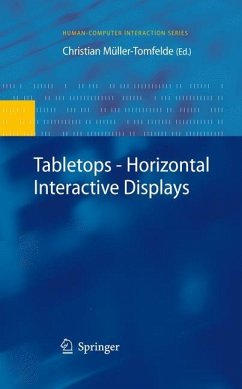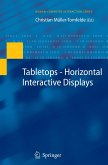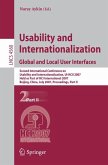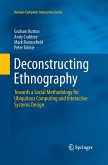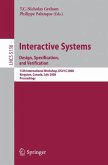This book is the first attempt to bring together current research findings in the domain of interactive horizontal displays. The novel compilation will integrate and summarise findings from the most important international tabletop research teams. It will provide a state-of-the art overview of this research domain and therefore allow for discussion of emerging and future directions in research and technology of interactive horizontal displays.
Latest advances in interaction and software technologies and their increasing availability beyond research labs, refuels the interest in interactive horizontal displays. In the early 1990s Mark Weiser's vision of Ubiquitous Computing redefined the notion of Human Computer Interaction. Interaction was no longer considered to happen only with standard desktop computers but also with elements of their environment.
This book is structured in three major areas: 'under', 'on/above' and 'around' tabletops. These areas are associated with different research disciplines such as Hardware/Software and Computer Science, Human Computer Interaction (HCI) and Computer Supported Collaborative Work (CSCW). However, the comprehensive and compelling presentation of the topic of the book results from its interdisciplinary character. The book addresses fellow researchers who are interested in this domain and practitioners considering interactive tabletops in real-world projects. It will also be a useful introduction into tabletop research that can be used for the academic curriculum.
The objects displayed on a table can take multiple forms. In meetings, it is still very often printed paper although its content was originally created on a computer. The content can also be a "table", but now in the mathematical sense, showing, e. g. , the budget of a project. Then, we have a "table" on the table. Most often, the computer-generated contents are subject of frequent changes or dynamic in nature. It is a logical consequence to avoid the detour and the inherent media break by transforming the surface of the table into a display able to show media that are active and can be computer-generated and computer-controlled. At the same time, it is desirable to maintain the inherent features and affordances of working with the objects and the contents while sitting or standing around a table. Electronic Meeting Rooms On the basis of these and other elaborate considerations, we started to design in 1992/1993 an electronic meeting room in Darmstadt at GMD-IPSI (later Fraunhofer IPSI). The setup of our custom-built DOLPHIN-System consisted of a "traditional" large rectangular wooden table with four physically integrated workstation-like computers with at screens. This set-up was complemented by linking a large ver- cal pen-operated interactive display, at that time the rst LiveBoard outside of Xerox PARC (two of which I was able to get to Darmstadt after my stay at Xerox PARC in 1990).
Latest advances in interaction and software technologies and their increasing availability beyond research labs, refuels the interest in interactive horizontal displays. In the early 1990s Mark Weiser's vision of Ubiquitous Computing redefined the notion of Human Computer Interaction. Interaction was no longer considered to happen only with standard desktop computers but also with elements of their environment.
This book is structured in three major areas: 'under', 'on/above' and 'around' tabletops. These areas are associated with different research disciplines such as Hardware/Software and Computer Science, Human Computer Interaction (HCI) and Computer Supported Collaborative Work (CSCW). However, the comprehensive and compelling presentation of the topic of the book results from its interdisciplinary character. The book addresses fellow researchers who are interested in this domain and practitioners considering interactive tabletops in real-world projects. It will also be a useful introduction into tabletop research that can be used for the academic curriculum.
The objects displayed on a table can take multiple forms. In meetings, it is still very often printed paper although its content was originally created on a computer. The content can also be a "table", but now in the mathematical sense, showing, e. g. , the budget of a project. Then, we have a "table" on the table. Most often, the computer-generated contents are subject of frequent changes or dynamic in nature. It is a logical consequence to avoid the detour and the inherent media break by transforming the surface of the table into a display able to show media that are active and can be computer-generated and computer-controlled. At the same time, it is desirable to maintain the inherent features and affordances of working with the objects and the contents while sitting or standing around a table. Electronic Meeting Rooms On the basis of these and other elaborate considerations, we started to design in 1992/1993 an electronic meeting room in Darmstadt at GMD-IPSI (later Fraunhofer IPSI). The setup of our custom-built DOLPHIN-System consisted of a "traditional" large rectangular wooden table with four physically integrated workstation-like computers with at screens. This set-up was complemented by linking a large ver- cal pen-operated interactive display, at that time the rst LiveBoard outside of Xerox PARC (two of which I was able to get to Darmstadt after my stay at Xerox PARC in 1990).
From the reviews:
"Müller-Tomfelde's book explores the research world around tabletop displays. The book is structured in three parts ... which correspond to three different research disciplines: hardware/software, human-computer interaction, and computer-supported cooperative work. ... The book achieves its goal. Fellow researchers will be able to get an introduction to the field of tabletop research. This is also an interesting book for software engineers, GUI designers, technical managers, and other practitioners who work with horizontal displays." (Gerald Friedland, ACM Computing Reviews, October, 2010)
"Müller-Tomfelde's book explores the research world around tabletop displays. The book is structured in three parts ... which correspond to three different research disciplines: hardware/software, human-computer interaction, and computer-supported cooperative work. ... The book achieves its goal. Fellow researchers will be able to get an introduction to the field of tabletop research. This is also an interesting book for software engineers, GUI designers, technical managers, and other practitioners who work with horizontal displays." (Gerald Friedland, ACM Computing Reviews, October, 2010)

